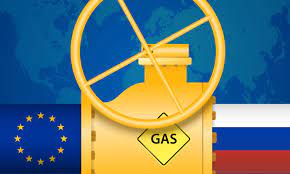Europe faces the risk of blackouts, rationing and a severe recession if Russia further slashes gas deliveries, and the next reality check is at hand.
A three-day halt of the Nord Stream pipeline — a key source of natural gas for the European Union — starts on Wednesday, and concerns are widespread that Moscow will find another excuse to clamp down on supplies, putting the region at the mercy of the weather.
Hours ahead of the outage, Gazprom set an unsettling tone by notifying French utility Engie that it would halt deliveries from Thursday because of a disagreement over payments. The move widens cutbacks to the continent as Moscow retaliates for sanctions related to its invasion of Ukraine.
The worst-case scenario would entail a complete cutoff of Russian gas to the region and an early cold snap. With few alternative supplies available, a surge in heating demand would propel prices to new heights, which could foment social unrest and test Europe’s resolve to support Ukraine.
Gazprom says routine maintenance and inspections are needed on a Nord Stream compressor station. It’s the latest installment of a cat-and-mouse game between the Kremlin and Europe as gradual cuts to supply have raised tension on energy markets. The work comes just weeks after a longer shut down this summer and with cooler fall temperatures looming.
The Kremlin points the finger at Europe, saying sanctions are the only obstacle to supplying gas via Nord Stream. A spare turbine that could boost deliveries has been stuck in limbo, with Moscow and Berlin arguing over which documents are needed to enable its return to Russia.
“There is a guarantee that, apart from technological problems caused by sanctions, nothing interferes” with gas deliveries, Kremlin spokesman Dmitry Peskov said on Tuesday.
Nord Stream flows were set to halt overnight, according to the operator. Prices indicate the market sees a 30% chance that deliveries through Europe’s main Russian gas link won’t return even at the drastically reduced levels of recent weeks, according to Leon Izbicki, a gas analyst at Energy Aspects.
Germany is at the epicenter of the crisis. It’s where Nord Stream links to the European gas grid, and the country’s homes and factories are heavily dependent on the fuel after decades building up a reliance on Russian energy.
Europe’s largest economy needs to reduce gas use by at least 20% and secure additional supplies to make it through the upcoming heating season, according to Klaus Mueller, president of Germany’s energy regulator.
“If we can do all that, we have a chance to get through this winter and next,” he told the Muenchner Merkur newspaper last week. “If we don’t make it, it can be difficult.”
Germany’s gas reserves are 83% full and even reaching the country’s 95% target would cover less than three months of heating, industrial and power demand if Russia cuts off supplies completely, Mueller said. His agency, known as BNetzA, would control gas distribution if an emergency is declared.
Europe’s energy risks
• Higher gas and power prices, which are linked, would deepen a cost-of-living crisis
• Social and political unrest if consumers struggle to heat homes and buy essentials
• Cold snaps in Asia and Europe would intensify global competition for limited LNG cargoes
• Continued drought could hamper shipping coal to power plants that are being revived to reduce gas use
Chancellor Olaf Scholz’s coalition is concluding a two-day retreat on Wednesday, as it seeks to rescue a bungled effort to pass on higher costs to consumers.
The urgency to prop up the energy sector, while also shielding vulnerable consumers, has intensified after Uniper — Germany’s biggest buyer of Russian gas — asked on Monday to extend its government credit line to 13 billion euros ($13 billion) to avoid collapse.
Commerzbank has warned of a “severe recession” in Germany if Russia were to completely halt gas supplies. While the country is among the most vulnerable, the risks extend to Austria and Italy, Fitch Ratings said in a report. Some other countries also receive Russian gas through their neighbors, and cuts may disrupt that trade.
Industries from zinc and aluminum to fertilizers are curbing production because of high enery prices. That could cause long-lasting damage to Europe’s economy if too many companies abandon operations.
“If prices remain at these levels, we will see much more demand destruction than is necessary,” said James Huckstepp, head of EMEA gas analytics at S&P Global Commodity Insights.
Despite the concerns, Russia is expected to maintain some level of supply to Europe, its main market for gas. If deliveries stop, that would curb a key source of the country’s revenue.
Goldman Sachs Group Inc. analysts said last week that a permanent Nord Stream halt isn’t their base-case scenario and are expecting flows to restart at the pre-maintenance level of 20% of capacity. That might be just enough to rescue Europe’s winter, according to Niek van Kouteren, a senior trader at Dutch energy company PZEM.
If there’s a normal winter, “things should be OK, given the current stock levels and reduced demand,” he said. “But obviously there are upside risks if there’s some early cold.”
So far the forecasts look promising. Temperatures are expected to be above average in early October, according to the European Center for Medium-Range Weather Forecasts.
Germany is also working hard to diversify its energy mix. The nation is restarting coal power plants and considering extending its remaining nuclear facilities. It’s also racing to connect its first floating LNG terminals this winter.
“We can deal quite well with the threats we are facing from Russia, which uses gas, for example, as part of its own strategy in the war against Ukraine,” Scholz said on Tuesday. “We’re prepared. That’s the good news.”

 Iran Energy News Oil, Gas, Petrochemical and Energy Field Specialized Channel
Iran Energy News Oil, Gas, Petrochemical and Energy Field Specialized Channel



